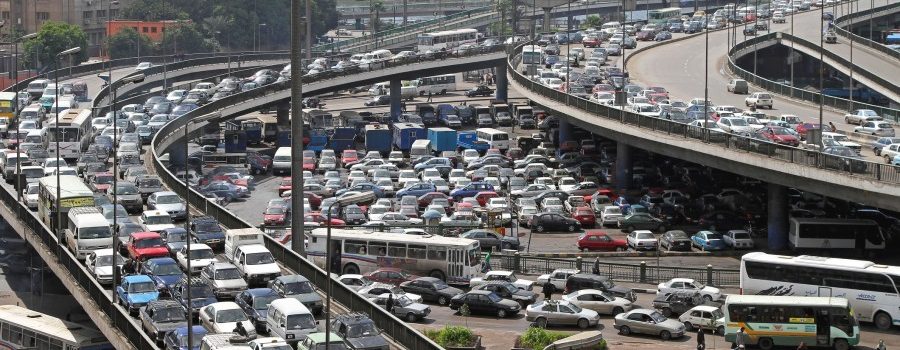Must the Past Be Prologue? Investing in a Transportation Future that Builds Sustainable Economies Globally

By Christine Weydig
This post originally appeared on LinkedIn by the Coalition for Reimagined Mobility.
A century of transportation dominated by internal combustion (ICE) vehicles is coming to an end in the rich world.
But as more than 100 heads of state and 35,000 delegates gather in Egypt for the annual United Nations Conference of Parties (COP), the question of how rich countries should use their resources to help less developed countries mitigate and adapt to climate change is front and center. The central challenge is how to enable them to continue to build up their economies and improve the lives of their people in a sustainable, less carbon-intensive way using technologies, innovative business models, and know-how that did not exist a century ago when the U.S. and Europe built their economies into the powerhouses they are today.
A big piece of the prosperity puzzle is passenger transportation, which will be a major growth area ripe for investment in sustainable systems as less developed countries build their economies in a way that aims to minimize pollution and other negative externalities that come with oil-dependent transportation.
Leapfrogging 20th Century Transportation Systems
The United Nations Development Programme found that from 2015 to 2020, rich countries exported 23 million used light duty vehicles to low- and middle-income countries. As the U.S. and EU move away from ICE vehicles, the volume of these older, more polluting vehicles that realize second lives in developing economies will increase. Greater supply of old ICE vehicles will likely mean they cost less, and more people could buy private cars, adding congestion and emissions that do not exist today and locking them into the volatile price of oil which always hurts the poorest countries and people who can least afford the oil as prices rise.
While access to private vehicles and the use of gasoline and diesel fuels were foundational to the economic growth and prosperity of nations in the 20th century, we have the resources and knowledge to help countries today grow their infrastructure and economies in more sustainable ways. And the reality is that many developing countries do not want the rich world’s dirtiest second-hand ICE vehicles, with the Economic Community of West African States even placing fuel standards and limitations on the age of vehicles that can be imported.
Complementary policies in developed countries could ensure collective transportation emissions are reduced, and can even promote more efficient use of scarce, costly materials. The European Union’s End-of-Life Vehicle directive aims to stop exporting old vehicles and promote domestic recycling of them, a practice that is an increasingly important way to improve supply chain resilience.
While policies focused on ensuring old ICE vehicles are retired and recycled are powerful, they can be amplified by investment in clean, reliable, and resilient modes of transportation to support economic growth and truly leapfrog the carbon-intensive transportation systems of last century.
Decarbonizing and Integrating Informal Transportation Services
A robust approach should also include investment in improving and legitimizing—not eliminating—informal transport systems that already exist in many of these countries. This is an aim already set by COP’s Low Carbon Transport for Urban Sustainability Challenge.
Traditional transportation thinking discourages informal transportation networks exclusively in favor of costly infrastructure projects like more roads for private automobiles and traditional mass transit systems typical in rich countries.
Right-sized transportation modes and informal services are popular and meet the needs of people living in the towns and cities of less developed countries, they just need investment to decarbonize and improve safety and reliability.
The Coalition for Reimagined Mobility’s analysis of business models to enhance adoption of connected, autonomous, shared, and electric (CASE) mobility identifies examples like Jakarta’s success in embracing and improving informal minibus services into its Bus Rapid Transit system through digitalized ticket integration and service contracting.
This approach can be used to embrace and support other kinds of electrified services like micromobility and two- and three-wheeler ride hailing services that are expected to see a compound annual growth rate of 25% between 2020 and 2025 in Asia, for example.
South Africa has recognized this potential and is planning to integrate—including digital ticketing—and improve its popular private minibus taxis into the public transport system.
Investing in CASE Mobility at Home and Abroad
As pressure increases for rich countries to honor their pledge of $100 billion a year to help less developed countries address climate change, the developed world can provide financial support, technical expertise, and deployment of electric vehicles and charging and communications infrastructure for integrated mobility systems. Moving past the oil dependent car-centered era of the last century to achieve right-sized, connected mobility systems that are not dependent on oil would also insulate economies from geopolitical volatility.
This would be a welcome contrast to China’s problematic Belt and Road Initiative that provides loans to poorer countries for development of carbon-intensive energy and transport infrastructure of questionable value and leaving them indebted to a dubious partner.
Transition to digitized, integrated CASE transport systems in developing economies can likely happen faster than in a developed nation like the U.S. given its outdated regulatory structures, litigious culture, and inflexible infrastructure built around private car ownership. With fewer barriers and competition from incumbent modes of transportation, investment in these modes would be relatively inexpensive and the payoffs significant. In parallel, developed nations should actively work to remove impediments to mobility innovation at home.
Climate change impacts us all—it does not know borders or nationalities. It is in our interest to help accelerate the transition to clean economies across the globe.
Christine Weydig is the Executive Director at the Coalition for Reimagined Mobility (ReMo).
